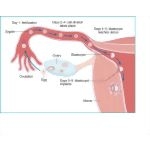What Causes Fallopian Tube Blockage?
 Fallopian tubes are two tubes present in the body of every normal woman. Each tube is on each side of the uterus and provides a passage for mature eggs to travel from ovaries to uterus. When there is an obstruction which prevents the eggs from traveling through the tube, it is said that the woman has blocked tube. It is possible that only one of the tubes is blocked or both the tubes can be blocked. This blockage is the cause of infertile women in about 40% cases.
Fallopian tubes are two tubes present in the body of every normal woman. Each tube is on each side of the uterus and provides a passage for mature eggs to travel from ovaries to uterus. When there is an obstruction which prevents the eggs from traveling through the tube, it is said that the woman has blocked tube. It is possible that only one of the tubes is blocked or both the tubes can be blocked. This blockage is the cause of infertile women in about 40% cases.
Each month, when ovulation takes place, an egg is released by the ovaries. This travels through the fallopian tube to the uterus. Likewise the sperm travels from cervix to get to the egg and fertilization normally take place in this tube. In case of blockage the egg cannot reach the uterus and the sperm cannot reach the egg, preventing pregnancy. The blockage can be total or partial, and it can be in one tube or both. There are many causes of fallopian tube blockage as follows:
In certain cases, due to infection, the fallopian tube gets dilated, its diameter increases and it fills up with liquid. The cause can be formation of antibodies in the tubes to control infection. The fluid filled up in the tube blocks the passage of both sperms and the eggs resulting in infertility. This state of blocking is known as Hydrosalpinx.
If one of the tubes is blocked and the other is open it is possible for pregnancy to happen. It is not necessary that all women suffering from blockage need to feel some symptoms. In certain cases there can be no symptoms while other women may suffer from lower abdominal pain and vaginal discharge. If there is some infection, feeling of pain during intercourse or during menstruation is possible. In case of a lady suffering from pelvic inflammation, she may experience irregular menstrual cycle.
In addition to infection, the blockage can be caused by sexually transmitted diseases, infection caused by miscarriage, rupture of appendix, abdominal or fallopian tube surgery. To detect blockage specialised X-ray is done. A dye is placed in the cervix and its flow is noticed by X-ray of the pelvic area.
To open the blocked fallopian tube, laparoscopic surgery can be done to open the tube or to remove the tissue which is blocking it. The chances of success depend upon the age of the patient. Younger is considered better. In case of only a few adhesions, after laparoscopic surgery the chances of pregnancy are bright. Other methods adopted for opening the blockages of fallopian tube includes surgical opening or replacing the portion of existing tube with a new tube. If there are large, multiple and thick adhesions surgery may not be a good option. It is better to go in for IVF treatment.